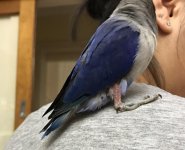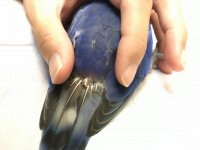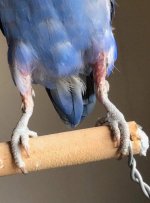BlueYellowGreen
New member
- Jun 11, 2019
- 3
- 0
Hi all,
I have a blue masked lovebird that has been suffering from a feather loss problem in the last 8 months I'd say, and is bald in specific areas - the legs (gradually extending to wings), the tail and a very small patch on his head. He also sometimes bleeds from his tail feathers as he has a blood feather there (I've attached a picture). I've also noticed in the past week he's been sleeping more often than usual, and I'm quite worried.
His diet mainly consists of seeds (he prefers the millet ones though), cuttlefish bone, leafy greens, multivitamin in the water and recently have been feeding him corn. Sometimes we also feed him dried pineapple. I'm not sure if it's a diet problem, but I don't think this is the problem for his feather loss.
Moreover, his mate (a lime fischer) does not appear to have any feather loss problems. So, I'm assuming that his problem isn't contagious, or that she is resistant to whatever he has.
The bald areas on his body doesn't seem to be inflamed, only a bit scaly. (I've also attached a picture of this).
I googled some common feather problems and I think the one that his symptoms most closely matches could be ringworm.
Does anyone have any experience of this with their birds? We were trying to help him without bringing him to the vet, mainly because of the expenses. We are willing to bring him to the vet if we have tried other options first though.
Thanks!
I have a blue masked lovebird that has been suffering from a feather loss problem in the last 8 months I'd say, and is bald in specific areas - the legs (gradually extending to wings), the tail and a very small patch on his head. He also sometimes bleeds from his tail feathers as he has a blood feather there (I've attached a picture). I've also noticed in the past week he's been sleeping more often than usual, and I'm quite worried.
His diet mainly consists of seeds (he prefers the millet ones though), cuttlefish bone, leafy greens, multivitamin in the water and recently have been feeding him corn. Sometimes we also feed him dried pineapple. I'm not sure if it's a diet problem, but I don't think this is the problem for his feather loss.
Moreover, his mate (a lime fischer) does not appear to have any feather loss problems. So, I'm assuming that his problem isn't contagious, or that she is resistant to whatever he has.
The bald areas on his body doesn't seem to be inflamed, only a bit scaly. (I've also attached a picture of this).
I googled some common feather problems and I think the one that his symptoms most closely matches could be ringworm.
Does anyone have any experience of this with their birds? We were trying to help him without bringing him to the vet, mainly because of the expenses. We are willing to bring him to the vet if we have tried other options first though.
Thanks!
Attachments
Last edited:


